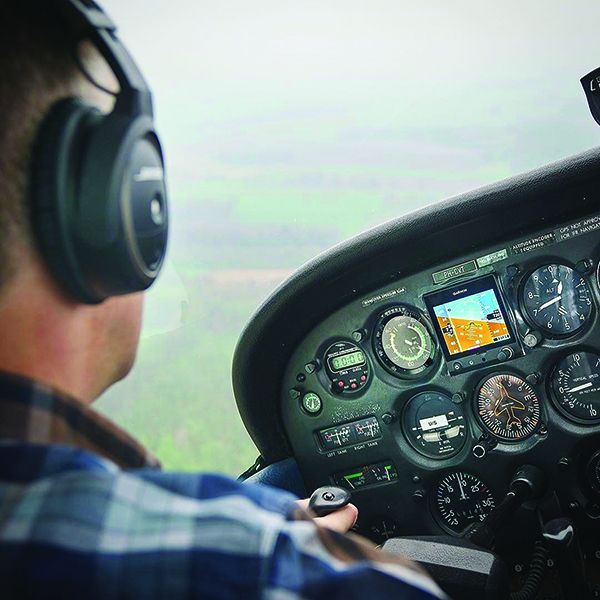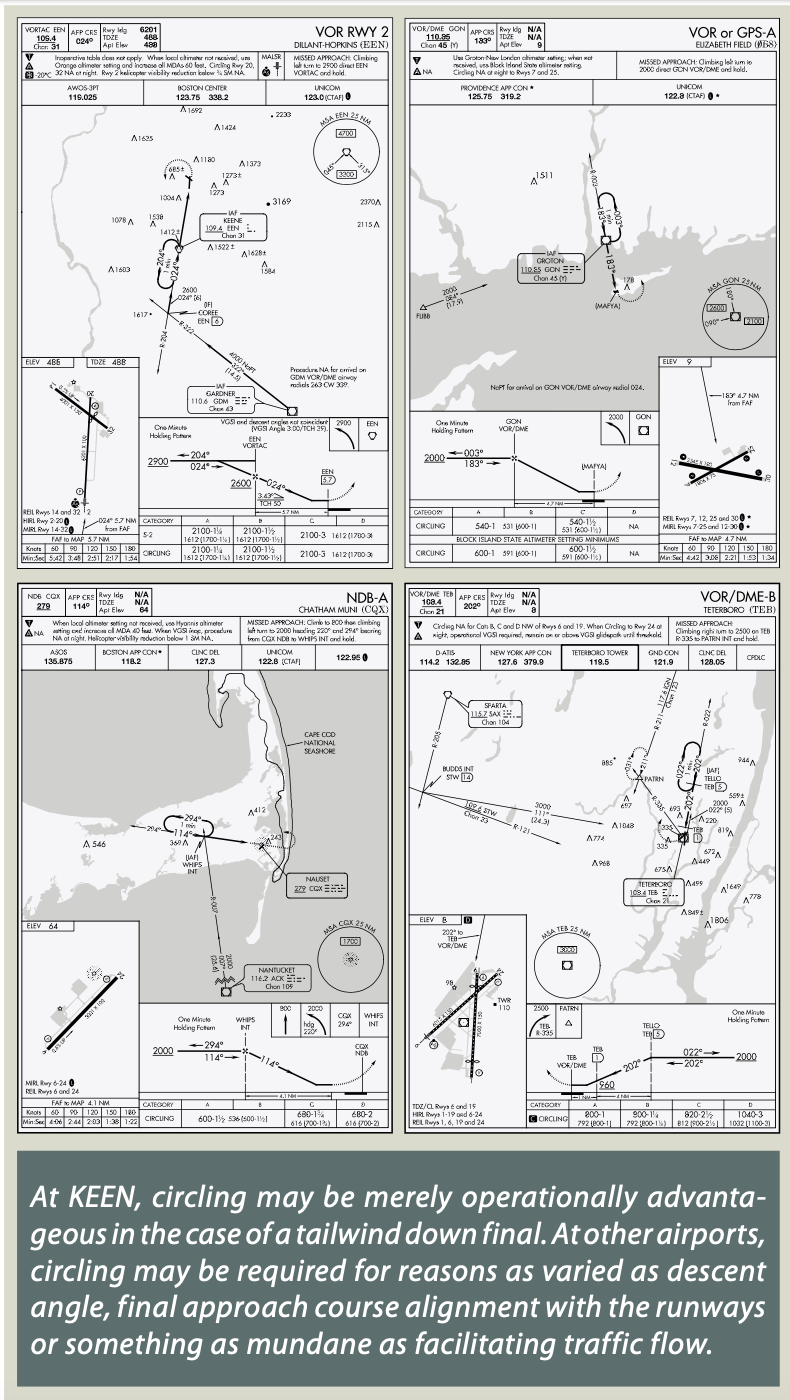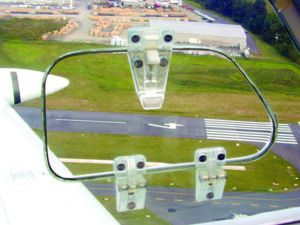
With the rise in quality and quantity of GPS approaches, especially at smaller airports, the beloved circling approach is becoming an infrequently used maneuver. That’s a shame, since circling to a preferred runway after breaking out on an approach can help resolve many challenges in the IFR environment. Having the confidence to circle is one more arrow in your quiver for that dark and stormy night.
For many, myself included, the majority of circling approaches flown are in the training environment these days. Since circling is not required for instrument currency, a pilot could theoretically never exercise circling skills yet legally descend all the way down to the appropriate minimums and circle to land on their next arrival. This can present several layers of risk. Maneuvering in marginally visual conditions, low to the ground within close proximity to the airport presents challenges to even the sharpest instrument pilots. That’s one reason it’s important to practice them.

WHY CIRCLE?
Even with the rising availability of straight-in approaches, there are a number of reasons why a circling approach is the best option. As a New England-based pilot, I took a look around at the airports and approaches near me and found some examples of circling approaches. All these examples are approaches I have actually had the pleasure of flying in the last few years.
Consider the Dillant-Hopkins Airport (KEEN) in Keene, N.H. There are three published approaches for Runway 02, but nothing for Runway 20. If the winds are strong and favoring Runway 20, a circling approach is the best bet for making it in if the field is marginal.
At other airports, if the approach course alignment and the runway centerline are greater than 30 degrees off, a circling approach is the only option. Consider the VOR or GPS A into the Elizabeth Field Airport (0B8), Fishers Island, N.Y. The approaches line up with midfield downwind on both runways, but that’s about it.
Circling minimums are the only ones available if the descent gradient is greater than 400 feet/nm from the FAF to the threshold crossing height (TCH). An example of this would be at Chatham Municipal Airport (KCQX) in Chatham, Mass., and specifically the RNAV B approach. The approach lines up nicely with Runway 24, but straight-in approach minimums are not published. This does not mean you cannot land straight-in out of the approach, but the responsibility of ensuring a safe descent from minimum descent altitude (MDA) to landing rests with the pilot.
The Teterboro Airport (KTEB) in Teterboro, N.J., offers another straight-in lookalike, the VOR/DME-B procedure. Probably for traffic-flow reasons, the approach facilitates a landing on either Runway 19 or 24 but only with circling minimums. It’s debatable whether this is really a circling approach, but the controllers at Teterboro frequently use circling in windy conditions to facilitate traffic within the very crowded New York City airspace. This was highlighted by a 2017 Learjet accident, which itself is worth studying for its valuable lessons.
Each of these scenarios presents its own unique risks and challenges. They can absolutely be accomplished safely, but preparedness and preparation are key. Part of that preparedness is knowing when and where circling approaches frequently go wrong.

You might notice there is an “inverse” C next to the circling minimums on some approaches. After a lot of feedback from the industry revolving around unstabilized approaches during the circling maneuver, the FAA revamped the approved circling radii. At right, the top table presents the standard circling radii, expressed in nautical miles, while the bottom table uses the new, expanded criteria. Presence of the “inverse” C, at top, denotes use of expanded distances.

This has a greater effect on high performance aircraft, but an extra bit of wiggle room can often be helpful. With the expanded radii, more speed is available to pilots flying the maneuver, and speed defines everything about how a circling approach is flown.
COMMON CIRCLING PITFALLS
In my time spent as a check airman and instructor, I had the good fortune of overseeing (and flying!) more circling approaches than I can count. Circling approaches—and non-precision approaches in general—were the items I most commonly had to retrain. Partially because they are challenging and partially for the same reasons discussed above, we just do not do them often in regular flying. So let’s discuss the most common failures when conducting circle approaches.
Vertical Guidance: Most approaches these days either have vertical guidance, or our modern avionics provide them for situational awareness. This is a fantastic feature, but unlike most approaches with vertical guidance, a circling approach will have a minimum descent altitude (MDA) instead of a decision height or altitude (DH/DA). Something I commonly see is a pilot descending to minimums, dutifully calling out each altitude right until minimums. There is a bit of shock factor at minimums, because we briefed a circling approach and they were expecting visual contact. At this time, two things can happen: flying below minimums or going missed prematurely. The former is obviously more hazardous, but when I query them about why they went missed immediately, there is always a “lightbulb” look of understanding on the pilot’s face. There is a dawning realization that they had the option to level off and continue to the MAP.
All The Way Down: Very rarely is it necessary to go all the way to minimums when we circle. The FAA’s Aeronautical Information Manual (AIM) has pretty clear guidance on this: “Pilots should remain at or above the circling altitude until the aircraft is continuously in a position from which a descent to a landing on the intended runway can be made.” Why make the maneuver any more challenging? If you break out at 1000 feet, and the minimums are 500 feet, level off at 900 feet or so. This is low enough to ensure that you will not reenter IMC and is much closer to a regular pattern altitude.
Keep It Stable: The stabilized approach concern gets a little trickier when you consider circling approaches. Chapter Four of the FAA’s Instrument Procedures Handbook (IPH, FAA-H-8083-16B) states approaches in IMC “must” be stabilized before descending below 1000 feet agl. For circling approaches, since they’re sort a hybrid visual/instrument maneuver, the IPH says the final segment “must” be stabilized by reaching 500 feet agl or at the MDA, whichever is lower. Which conveniently segues into my next point.
Keep Your Distance: It is critical to have a full understanding of how much ground clearance you have while conducting circling approaches. First, you have some flexibility on what category you fly the approach at. One positive change the FAA has made to circling approaches (and approaches in general) is the defining category can be determined by planned approach speed, rather than a VREF of 1.3 VSO. This allows pilots to plan for the approach that they intend to fly, rather than an arbitrary speed that may or may not be flown. Just remember, you can only use planned airspeed to increase your approach category, not decrease it. If your published VREF speed is 95 KIAS, you cannot shoot a Category A approach even if you are light and flying the approach at 85 knots.
Once you have decided how fast you would like to fly the approach, consult the chart of either normal or expanded circling minimums. For example, let’s say that you want to circle at 100 knots. That places you in Category B. Assuming the approach has minimums for Category B, you will have at least 1.5 miles of clearance from all runway thresholds. In my experience, pilots are so concerned with not exceeding that distance that the pattern they fly ends up essentially forcing an unstable approach. This can manifest as either an overshoot, which can result in a significant overbanking situation extremely low to the ground, or a long landing.
Most of the airports with prominent circling approaches do not exactly have runway length to spare. Something I use for a quick reference is the length of the runway: If you are circling to a 5000-foot-long runway, you have one and half of that runway length of guaranteed obstacle clearance. Additionally, most GPSs will provide DME information. (Always ensure you know the datum from which distance is measured, whether it is the middle of the airport, the runway or the missed approach point.)
This can be a delicate balancing act. When maneuvering a single-engine airplane to a runway, a goal should be to remain within gliding distance whenever possible. A low circling approach, especially when I am recommending utilizing more of that provided obstacle clearance, may take you briefly outside of gliding range. Each approach is different, and the risk of both an engine failure and an overshoot must be considered. It is absolutely possible to mitigate both, especially with planning and practice.
The Left Of Way: It may be tempting to take the shortest path to landing, but the AIM has this to say. “It should be recognized that circling maneuvers may be made while VFR or other flying is in progress at the airport. Standard left turns or specific instruction from the controller for maneuvering must be considered when circling to land.” It is perfectly acceptable and sometimes beneficial to overfly the field to enter the appropriate pattern.

The Instrument Procedures Handbook reminds us that “Pilots should remain at or above the circling altitude until the aircraft is continuously in a position from which a descent to a landing on the intended runway can be made at a normal rate of descent and using normal maneuvers.”
Depending on your circling MDA, you may be departing the MDA on the downwind, base or final. Next time you are flying a normal pattern, see where you are at different altitudes. If you find that you are normally on a two-mile base at 700 feet, you will know exactly when to depart MDA when your minimums are close to 700 feet.
HOW TO STAY AHEAD
If you are not feeling comfortable with the idea of shooting a circling approach, the best advice I have is to go out and practice. Pick a beautiful VFR day and just fly the approach and circle. This can be especially helpful with different altitudes. A circling approach at 500 feet feels much different than one closer to pattern altitude. After a couple of dry runs, your comfort level will increase substantially. Flying with an instructor can help provide some additional confidence, especially if you have a flight review or IPC coming up.
I am sure everyone here has heard the old adage, “The first step to a good landing is a good approach.” Well, I am of the firm opinion that the first step to a good approach is a good briefing. It was a common occurrence that I would see a student brief a fantastic approach and completely neglect to plan the final segment from MDA to runway. Knowing what pitch and power setting you need to level off in your specific configuration, how you will fly your pattern and when you will depart MDA will keep you ahead of the airplane. It certainly does not hurt to keep a little extra speed in, especially until you are comfortably established in the maneuver.

This article’s main text includes reference to a Learjet accident after an ill-fated circling approach into Teterboro. The accident had a number of contributing factors. Despite everything that happened leading up to the event, the flight was not doomed until the crew decided to force the late circling approach. In some accidents, like this one, removing only the last link in the chain of events leading to the accident would have saved the crew’s life.
One reason there is hesitation about going missed during a circling approach is confusion on how to do it. The simple answer from a review of AIM paragraph 5-4-21 is to make a climbing turn toward the landing runway and continue the turn until established on the missed approach course. Have a plan on accomplishing this at each point in the maneuver and brief it thoroughly. It’s not something you want to have to figure it out on the fly.
COMING FULL CIRCLE
While the circling approach is not in its heyday, it’s not dead yet, either. A number of scenarios exist where the only way you will be able to make it to your destination is with a well-executed circling maneuver. Until the day where each of our runways are equipped with straight-in RNAV approaches, it is a worthy endeavor for every instrument pilot to maintain proficiency flying a circling maneuver.
Ryan Motte is a Massachusetts-based Part 135 pilot, flight instructor and check airman. He moonlights as Director of Safety when he isn’t flying.



